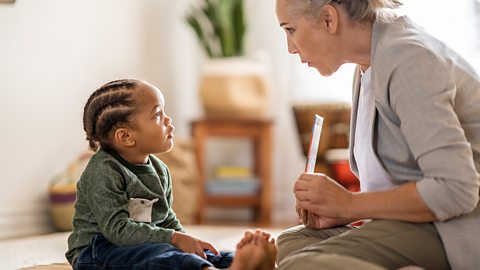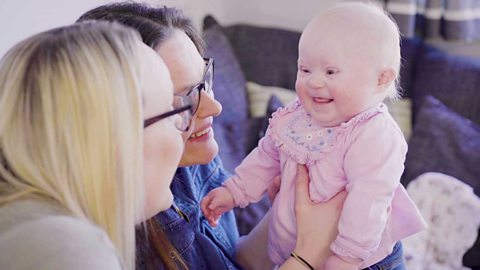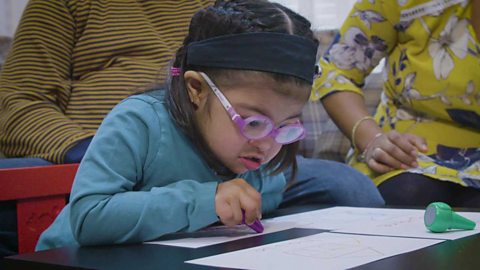When you put your babyâs bib on, do they seem to know itâs dinner time even before their food appears?
Babies and children use clues from the objects around them to help them understand your words and their routines. As your child grows older, they might not be able to remember the name of the new toy they want, but show them a page of toys on a website and they can quickly point it out!
For children who are finding spoken words harder to understand and use, we can make the most of these other visual ways of supporting communication.
Objects
Babies and children first learn to anticipate their everyday routines. For example, a babyâs bib is a clue that itâs dinner time, and dad standing by the door holding a coat is a sign itâs time to go out.
You can use this to help your child understand whatâs going to happen next alongside your words. Try showing your child one of the objects you use in the routine before you do it together, for example showing them their nappy before you change it.
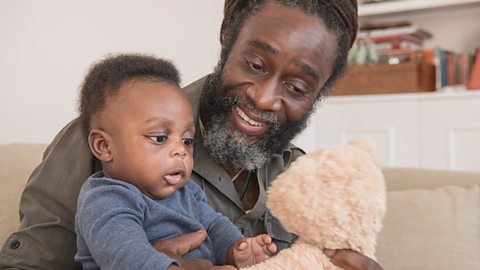
You can also pick an object to show to them before you go to different locations out of the house. For example, a leaf or twig to show youâre going to the park, or a piece of paper (a pretend shopping list) that they hold when you do your supermarket shop.
If you always give them the same small object, saying âweâre going to the parkâ, theyâll soon make the link.
This might help your child move on between activities more easily, particularly if youâre asking them to stop playing a favourite game to come for dinner!
Linking objects to your childâs activities like this is sometimes called giving them âobjects of referenceâ.
Objects are also really helpful when giving your child a choice.
Here are a few benefits of showing your child the two things they can choose between:
- Draws your childâs attention to your words.
- Helps your child understand exactly whatâs on offer.
- Stops your child having to remember two pieces of spoken information at once.
- Gives your child something to point at if they donât yet know the word, canât remember it, or say it clearly.
Itâs worth knowing that children can only focus on one thing at a time â showing objects as well as talking about them means youâre more likely to hold their attention.
Once your child can use objects to make choices for items they will get straight away, they can start to make choices about things in the future, like activities that you are going to do a little later.
For example, if you often play with a ball at the park, you can start showing your child the ball before you leave the house so they know youâre going to the park together.
Maybe your child also likes going to feed the ducks and theyâve linked being given the bread bag with a trip to the pond. You could show your child both the bread bag and the ball before you leave the house so that they can then choose where they want to go.
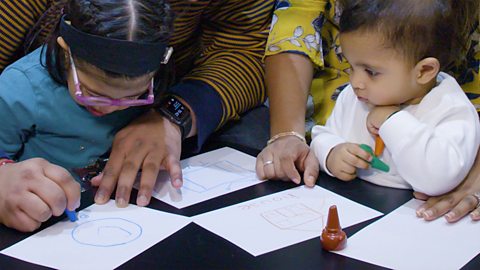
Pictures
Sometimes itâs just not possible to hold up the real objects to help your child understand what youâre saying, or to help them make choices. This is when photos and pictures are really helpful.
Pictures could be used for:
- Different locations out and about that your child often goes to.
- People your child sees regularly, so you can show them whoâs coming round or whoâs going to be looking after them.
- Meals, so you can show your child whatâs for tea before you start cooking it.
To make a simple choice board with photos, stick to two options to start off with, for example âDo you want to have pasta or fish fingers?â, showing photos of both meals side by side.
Once your child can cope with having two options and is pointing or saying a clear choice, you can try giving three or four different options.
Find out more about the power of pictures for communication.
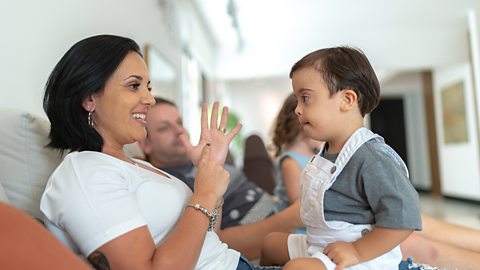
Signing
If youâve watched Something Special with Mr Tumble, youâll have noticed they use signs whilst they talk and sing. These are Makaton signs.
Children enjoy copying the signs, but they are so much more than fun actions.
Makaton signs make spoken words visual, giving children something to look at as well as listen to.
This helps children understand and remember words. Handily, they also slow down our talking, which helps children to understand too.
Although some parents worry that using signing like Makaton will stop their child talking, this isnât the case â research shows it helps children learn language and we always talk at the same time as using Makaton signs.
Makaton helps all children, but children with a hearing impairment might instead learn British Sign Language (BSL). As the name suggests, this is a full language, which has its own sentence structures and grammar (itâs not based on spoken English like Makaton).
Whichever signs your child is learning, the more people in their lives who learn them too, the more chances your child will have to communicate.
Article produced with help from Alys Mathers, a Highly Specialist Speech and Language Therapist who works with children who have a wide range of speech, language and communication needs.

